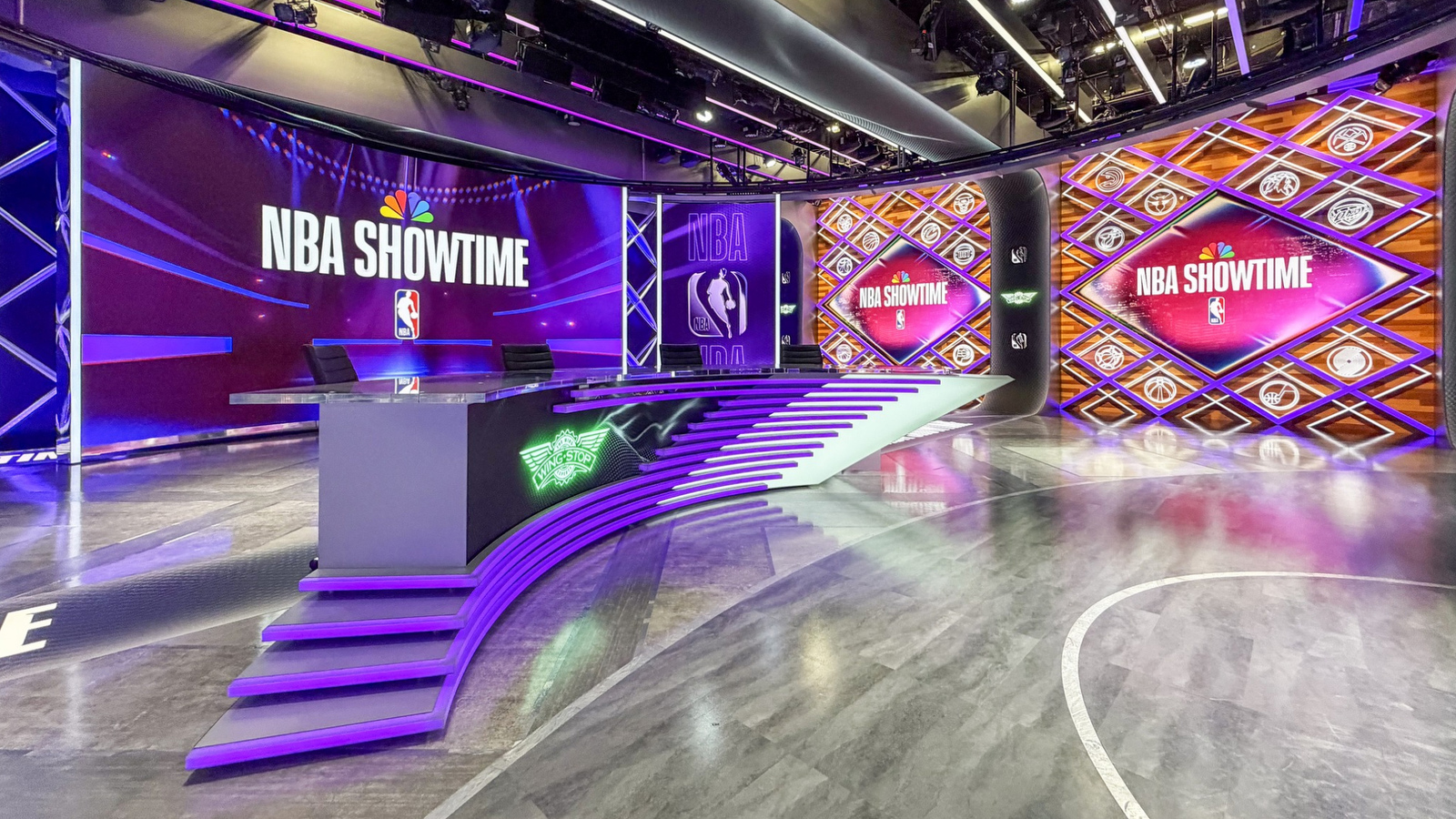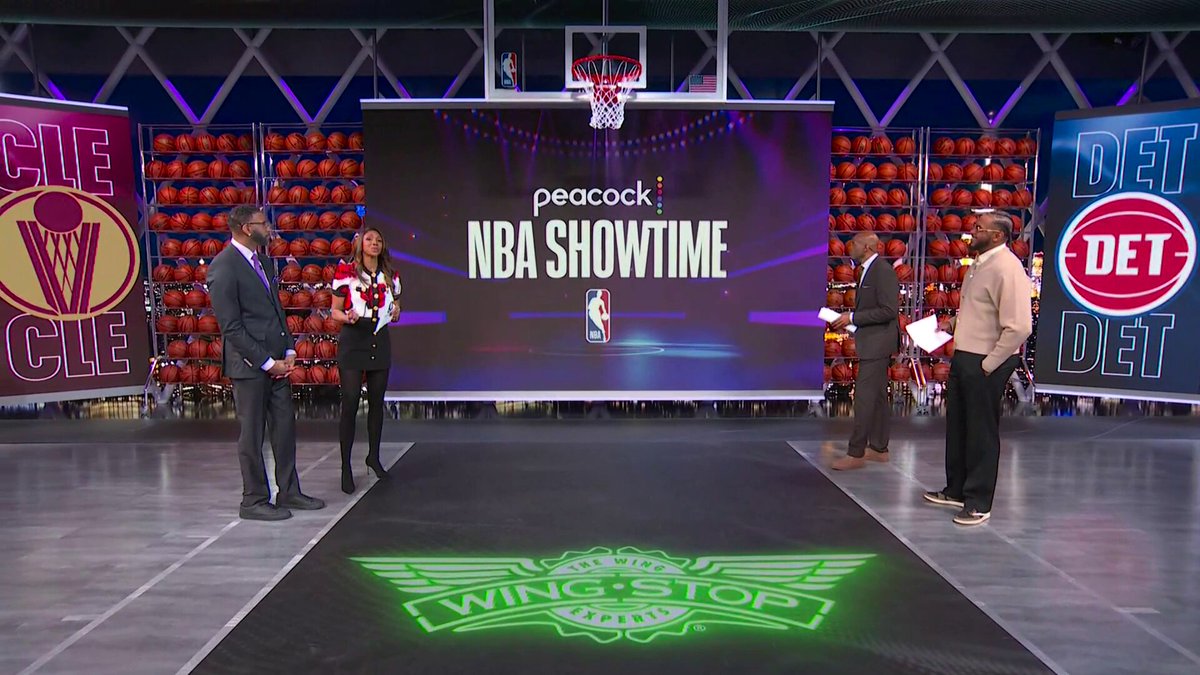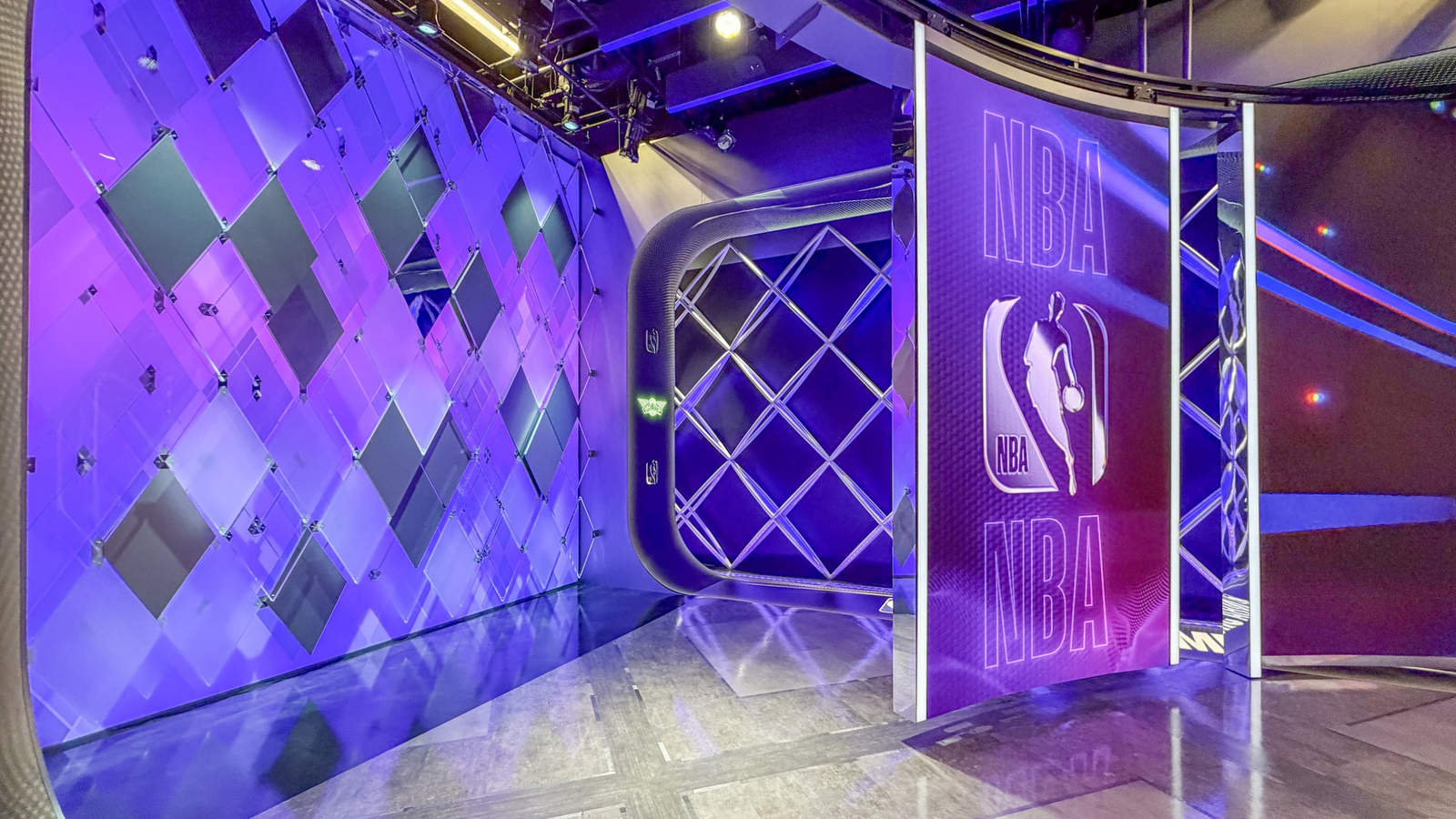NBA returns to NBC with flexible studio designed around talent, technology

Subscribe to NCS for the latest news, project case studies and product announcements in broadcast technology, creative design and engineering delivered to your inbox.
NBC Sports has invested significantly to bring NBA back to its airwaves after 22 years, and the network’s approach to studio production reflects both the scale of that investment and the complexity of modern sports broadcasting.
Central to the effort is the refreshed Studio 1 in Stamford, Connecticut, a 7,000-square-foot facility designed to transform between NBA broadcasts, college sports and Olympics coverage while creating distinct experiences for different platforms and audiences.
“From day one, we knew we wanted to put a large emphasis on the studio,” said Jared Sumner, who is directing studio production for “NBA on NBC,” including pre- and post-game show “NBA Showtime.”
The network has already earned positive reviews for its early broadcasts, with viewers responding to what Sumner calls a celebration of the game that includes nostalgic touches like John Tesh’s “Roundball Rock” theme.
A studio that changes personality
Studio 1 is designed to accommodate Peacock-exclusive broadcasts and those airing on NBC, offering distinct approaches for each.
“One of the things right off the bat was how we wanted to treat the Monday Peacock shows a little differently from the Tuesday Peacock and NBC shows,” Sumner explained. “For us, that meant using the studio in different ways.”
Monday broadcasts, branded as “Peacock NBA Monday,” center on what the production team calls the demo area, a half court complete with floor LED and a basketball hoop where analysts Tracy McGrady, Vince Carter and Carmelo Anthony stand and move freely during the show.
“It’s more of a casual feel,” Sumner said. “Our analysts are standing up and kind of moving around. They have the ability to go grab a ball off the rack and shoot around if they want to while they’re on air and just give it a little bit more of that laid back vibe.”

“Coast 2 Coast Tuesday” shifts to what Sumner describes as a more “high end studio show,” with the analysts seated at a desk in the studio’s home base area, shooting from the opposite direction of the demo area.
Then, beginning in February 2026, “Sunday Night Basketball” will find even more ways to utilize the space.
Designing for flexibility
Designed by HD Studio with fabrication by Mystic Custom Fabrication, the new set was created to adapt to NBC’s various properties — such as “Big Ten Saturday Night” — while still giving the “NBA on NBC” a unique home.
“The space has to be very flexible,” said Bryan Higgason of HD Studio.

“While it is the home of ‘NBA on NBC,’ it is also used for NCAA Football, NCAA Basketball and Olympic coverage,” Higgason said. “The tracking LED screens allow for flexibility in the use of the space, but it’s the scale that allows us to sculpt the space and reshape it.”
Four LED bands wrap the studio from floor to ceiling, creating what Higgason calls “a dynamic ability to alter the atmosphere and energy of the broadcast.” The entire space uses LED lighting, allowing instant color palette changes to match different shows’ graphics packages.
“With numerous reconfigurable tracking LED screens, you will continue to see the space change and grow over the season,” Higgason said.
The set integrates Planar and Leyard LED technologies across several areas. The arches include a mix of Leyard ALF Series 1.9mm, Planar CarbonLight CLI 1.9mm and CarbonLight CLI Flex 1.9mm, while tracked walls use CarbonLight CLI 1.9mm and 1.5mm panels. Legacy displays incorporate Planar TVF Series 0.9mm and Leyard LN Series 1.9mm models.
Camera technology includes a jib equipped with a Stype AR tracker for augmented reality integration and a PTZ “slamcam” positioned behind the backboard for dynamic basketball shots. The studio also features 4K monitors throughout and touchscreens for interactive analysis.
Atila Ozkaplan and Mike Sheehan, NBC Olympics coordinating director, guided the studio development on the production side.
The Lighting Design Group handled lighting design for display integration from Greg Gerner Inc.
Analog touches in a digital world
Despite the LED-heavy environment, the studio incorporates tactile elements that ground the space. The standout feature is the logo wall with 30 etched glass panels representing each NBA team, backlit with LED for color flexibility.
“The logo wall is a unique feature with a more analog approach,” Higgason noted. “The panels are lit with LED so we can play with color to adjust the focus of the wall.”


The panels can be swapped for Big 10 teams during college football season or Olympic pictograms during Games coverage. Sumner pointed out a thoughtful detail: When Carmelo Anthony sits in his camera-right position, the New York Knicks logo appears behind him throughout the show.
“It’s just one of those things that you can play around with,” Sumner said. “There’s so many different little… I’m calling them Easter eggs. So many little things in the studio that you can change around.”
Entering the AR arena
NBA coverage includes augmented reality for breaking down plays using a system called Sandbox, which layers plays on a touch display with shot charts and heat maps.
“It also has the capability to do a full five-on-five breakdown of a play where our analysts will stand over the display and move guys around and actually recreate a play,” Sumner explained. The system can also show what might have been, illustrating how a play might have worked better, taking analysis beyond simple replay.
The technology builds on NBC’s use of the Sandbox system during Tour de France coverage, where announcers manipulated AR graphics of riders.
“For the NBA, they’ll be able to move around players [on a virtual basketball court],” added Sumner.
Sumner acknowledged this represents NBC Sports’ “entry point into AR and VR.” The soft launch approach allows the production team to gradually introduce viewers to the technology while maintaining the network’s traditionally practical approach to production.
Leading with talent
While the technical capabilities are extensive, Sumner emphasized that storytelling remains paramount.
The analyst team of McGrady, Carter and Anthony — all former NBA stars who played during NBC’s previous NBA era — brings both credibility and personal investment to the broadcasts.

“Right away in rehearsals, we saw how comfortable they were with one another,” Sumner said. “For us, it’s really just giving them the platform. At the end of the day, we could do all these cool, amazing things in the studio, but what it comes down to is what our talent are talking about.”
The Monday night “On the Bench” concept extends this philosophy, with analysts sitting on team benches during Peacock-exclusive games. The casual Monday studio setup mirrors this approach, encouraging more analytical deep dives using the Sandbox system and the studio’s video walls.
“There’s been so many times throughout this process where I’ve been in a room with Carmelo and Tracy McGrady and Vince Carter and just hearing them tell their stories,” Sumner said. “For Vince and T-Mac especially, playing on NBC when they were coming up, it’s just like, wow, I can’t wait until they can actually go on air and tell these stories for the world to hear.”
Studio 1’s refresh represents the latest chapter in NBC Sports’ facility management. The space previously housed “Football Night in America,” which relocated to Studio 3 a few seasons ago.
Early audience response has been positive, with viewers praising NBC’s approach and embrace of nostalgia. Sumner said the network is focused on its own vision rather than external comparisons.
“Everything we do, whether it’s on the studio side or on the game side, is really about celebrating and educating the game,” he said.
“In a lot of ways, the studio has sort of become its own character,” Sumner reflected. “Every night of the week you’ll see every area of the studio utilized.”
Subscribe to NCS for the latest news, project case studies and product announcements in broadcast technology, creative design and engineering delivered to your inbox.






tags
Basketball, Bryan Higgason, Greg Gerner Inc., HD Studio, Mystic Custom Fabrication, NBA, NBA on NBC, nbc sports, nbc sports group, peacock, Planar, Stype, Stype RedSpy, The Lighting Design Group
categories
Heroes, Set Design, Sports Broadcasting & Production, Sports Set Design